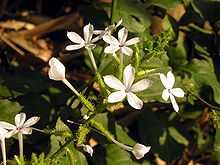Plumbago zeylanica
| Plumbago zeylanica | |
|---|---|
 | |
| Scientific classification | |
| Kingdom: | Plantae |
| (unranked): | Angiosperms |
| (unranked): | Eudicots |
| (unranked): | Core eudicots |
| Order: | Caryophyllales |
| Family: | Plumbaginaceae |
| Genus: | Plumbago |
| Species: | P. zeylanica |
| Binomial name | |
| Plumbago zeylanica L. | |
| Synonyms | |
|
Plumbago scandens L.[1] | |
Plumbago zeylanica, commonly known as Ceylon Leadwort or Doctorbush,[2] is a species of plumbago with a pantropical distribution. Carl Linnaeus described the paleotropical P. zeylanica and neotropical P. scandens as separate species, but they are currently considered synonymous. Ceylon Leadwort is a herbaceous plant with glabrous stems that are climbing, prostrate, or erect. The leaves are petiolate or sessile and have ovate, lance-elliptic, or spatulate to oblanceolate blades that measure 5-9 × 2.5-4 cm in length. Bases are attenuate while apexes are acute, acuminate, or obtuse. Inflorescences are 3-15 cm in length and have glandular, viscid rachises. Bracts are lanceolate and 3-7 × 1-2 mm long. The heterostylous flowers have white corollas 17-33 mm in diameter and tubes 12.5-28 mm in length. Capsules are 7.5-8 mm long and contain are reddish brown to dark brown seeds.[1]
Plant extracts have shown potent mosquito larvicidal activity against the larvae of Aedes aegypti while showing no toxicity to fish[3]
Hexane extracts of Plumbago zeylanica have shown activity against canine distemper virus.[4]
Hexane extract of plumbago zeylanicaPlumbagin shows Antimicrobial activity[5]
Methanol extract of plumbago zeylanicaPositive inotropic activity[6]
Enzymatic spectrum of herbal Plants Plumbago Linn. [7]
Bioactive spectra of Plumbagin. [8]
methanol extract of plumbago zeylanica shows effect on root- knot nematode Meloidogyne spp. [9].
References
- ↑ 1.0 1.1 "Plumbago zeylanica Linnaeus, Sp. Pl. 1: 151. 1753.". Flora of North America. eFloras.org. Retrieved 2011-06-30.
- ↑ "Taxon: Plumbago zeylanica L.". Germplasm Resources Information Network. United States Department of Agriculture. 1996-03-19. Retrieved 2011-02-23.
- ↑ Patil CD, Patil SV, Salunke BK, Salunkhe RB"Bioefficacy of Plumbago zeylanica (Plumbaginaceae) and Cestrum nocturnum (Solanaceae) plant extracts against Aedes aegypti (Diptera: Culicide) and nontarget fish Poecilia reticulata. Parasitol Res." 2011 May;108(5):1253-63
- ↑ Bagla VP, McGaw LJ, Eloff JN"The antiviral activity of six South African plants traditionally used against infections in ethnoveterinary medicine." Vet Microbiol. 2011 Sep 17;
5. Dama L.B., Poul B.N.and Jadhav B.V. (1998). Antimicrobial activity of Napthoquinonic compounds. J. Ecotoxicol. Environ. Monit. 8:213-215.
6. Poul B.N, Dama L.B.,and Jadhav B.V. (1999). Positive inotropic activity of Plumbagin. D. E. I. J. Sci. Engineering Res. 11: 26-29.
7. Poul B. N., Dama L.B. and Jadhav B. V. (1999). Enzymatic spectrum of herbal Plants Plumbago Linn. Asian J. Chem. 11(1):273-275.
8. Poul B. N., DamaL.B. and Jadhav B. V. (1999). Bioactive spectra of Plumbagin. Asian J. Chem. 11 (1):144-148.
9. Dama L.B. (2002). Effect of naturally occurring napthoquinones on root- knot nematode Meloidogyne spp. Indian Phytopathology. 55 (1): 67-69.
External links
![]() Media related to Plumbago zeylanica at Wikimedia Commons
Media related to Plumbago zeylanica at Wikimedia Commons
![]() Data related to Plumbago zeylanica at Wikispecies
Data related to Plumbago zeylanica at Wikispecies